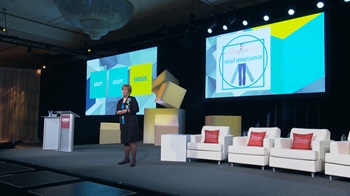Excerpt from FMI's State of the Industry Address at 2019 Midwinter Executive Conference
By: Leslie G. Sarasin, President and CEO, Food Marketing Institute
 Let’s face it, no one really likes change. We can talk about embracing it, but the simple truth is, we resist it until it’s foisted upon us and we’re forced to deal with it. Change takes us into the unknown, the uncertain and the unsure, while we prefer the reliable, the familiar and the predictable.
Let’s face it, no one really likes change. We can talk about embracing it, but the simple truth is, we resist it until it’s foisted upon us and we’re forced to deal with it. Change takes us into the unknown, the uncertain and the unsure, while we prefer the reliable, the familiar and the predictable.
We may not relish the discomfort that change brings, but we humans are usually, if not always, at our best when confronting and dealing with the difficulties it presents. The last ten years have shown us just how differently retail can be approached; and the competitive landscape not only continued to broaden, the very nature of the game shifted.
During these rapidly changing times, the food retail industry is demonstrating the ability to rise to the challenge. Our enhanced ability to adapt, adopt and evolve is preparing us for the next golden era of food retail, doing what we do, smarter and better. We stand poised to be the Da Vincis and the Michelangelos, leading the emerging renaissance of retail.
We’ve learned through our U.S. Grocery Shopper Trends research that customers do not want to be treated as a part of a category; they prefer to be respected as an individual. The retail renaissance expectations of personalization and customization are placing new and somewhat ironic demands on consumer research. The very notion of personalization belies being placed or categorized within a group, forcing researchers to rethink the way they have traditionally organized and interpreted their data.
The bottom line is our shared customer is demanding more information and more engagement with their food; and that necessitates our being more deeply aligned in providing food facts clearly. As trusted allies to consumers, food retailers are in a unique position to play the crucial role of connecting our customer with reliable trustworthy information. In a scientifically reliant industry, we must become more adept at creating bridges to a scientifically skeptical world. One thing is certain in the retail renaissance, we need to become more comfortable talking technology, science and nutritional facts.
As consumers request more information about their food purchases than ever before, so much so, the lines between suppliers and retailers are getting further blurred. Shoppers don’t want to hear a business lesson on how the supply chain allocates roles and responsibilities, they simply think if you sell it, you should know about it. The old supply chain, with its individual links, has disappeared. More so, it has fused into a single interwoven fiber optic cable with which collaborators must trust one another with the information within their grasp.
At FMI, we consider SmartLabel® among the most hopeful transparency tools available to us and to the consumer. If utilized properly and collaboratively, SmartLabel has amazing potential as a channel of providing clear and accessible information to the consumer. But executing this technology correctly will necessitate ongoing-honest-conversation between retailers and manufacturers – so we can share complete and accurate information with one another and with the customer.
To better serve the consumer, the new retail renaissance calls for increased integration and synchronization between suppliers and retailers. We must find the creative means to deal with our differences, seek the common ground, and stay focused on our shared goal of serving the food-consuming public.
This is why FMI’s leadership recently changed our Bylaws to create a new member category for product suppliers. We want to be the place where retailers of all sizes and styles sit down together with their manufacturer partners and service providers, all at one table, working collaboratively for the good of the larger food industry. I say “we want FMI to be this place,” but quite honestly, we seek it because changes in the retail landscape, changes in the manufacturing landscape and changes in the association landscape necessitate that such a common ground be created.
We invite you to help us realize this vision of a more unified industry, finding unity within our diversity and power within our solidarity. Thank you for the role you play in the new retail renaissance.


 Industry Topics address your specific area of expertise with resources, reports, events and more.
Industry Topics address your specific area of expertise with resources, reports, events and more.
 Our Research covers consumer behavior and retail operation benchmarks so you can make informed business decisions.
Our Research covers consumer behavior and retail operation benchmarks so you can make informed business decisions.
 Events and Education including online and in-person help you advance your food retail career.
Events and Education including online and in-person help you advance your food retail career.
 Food Safety training, resources and guidance that help you create a company food safety culture.
Food Safety training, resources and guidance that help you create a company food safety culture.
 Government Affairs work — federal and state — on the latest food industry policy, regulatory and legislative issues.
Government Affairs work — federal and state — on the latest food industry policy, regulatory and legislative issues.
 Get Involved. From industry awards to newsletters and committees, these resources help you take advantage of your membership.
Get Involved. From industry awards to newsletters and committees, these resources help you take advantage of your membership.
 Best practices, guidance documents, infographics, signage and more for the food industry on the COVID-19 pandemic.
Best practices, guidance documents, infographics, signage and more for the food industry on the COVID-19 pandemic.
